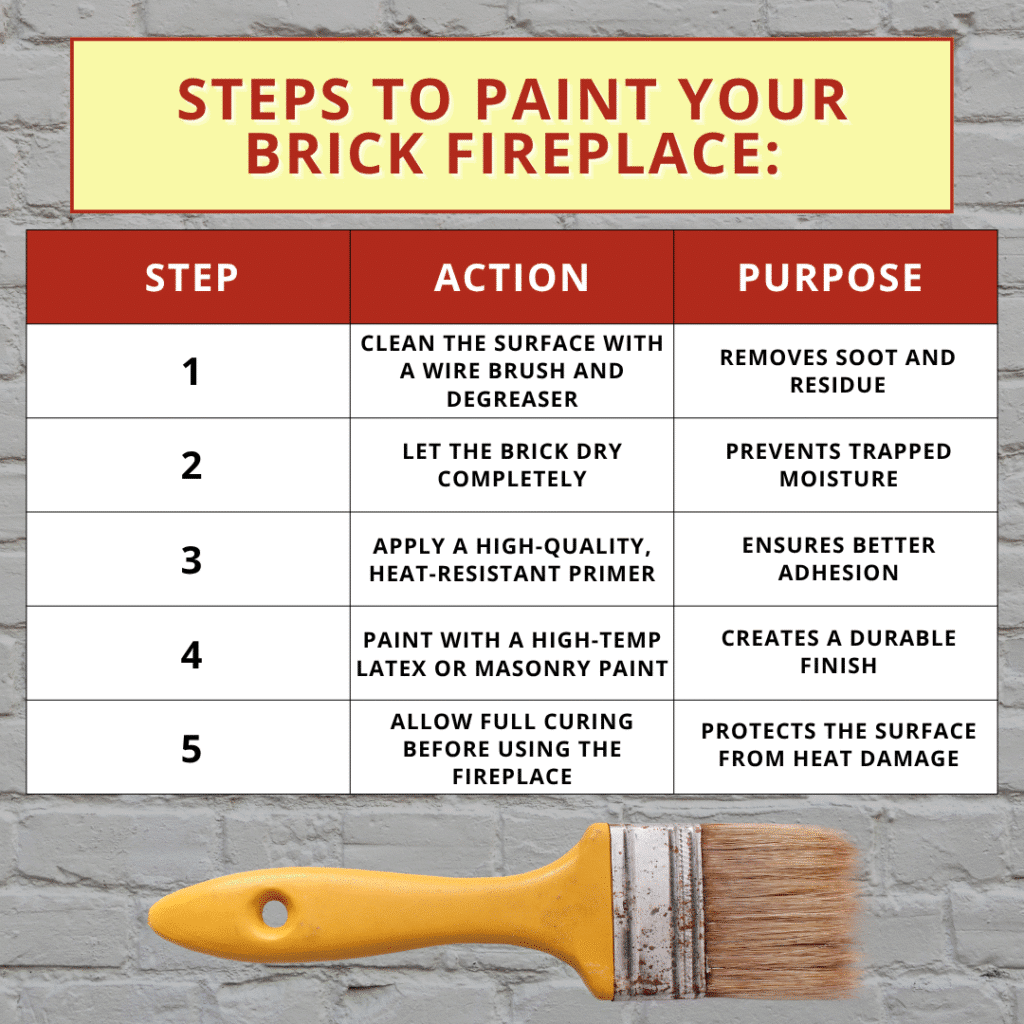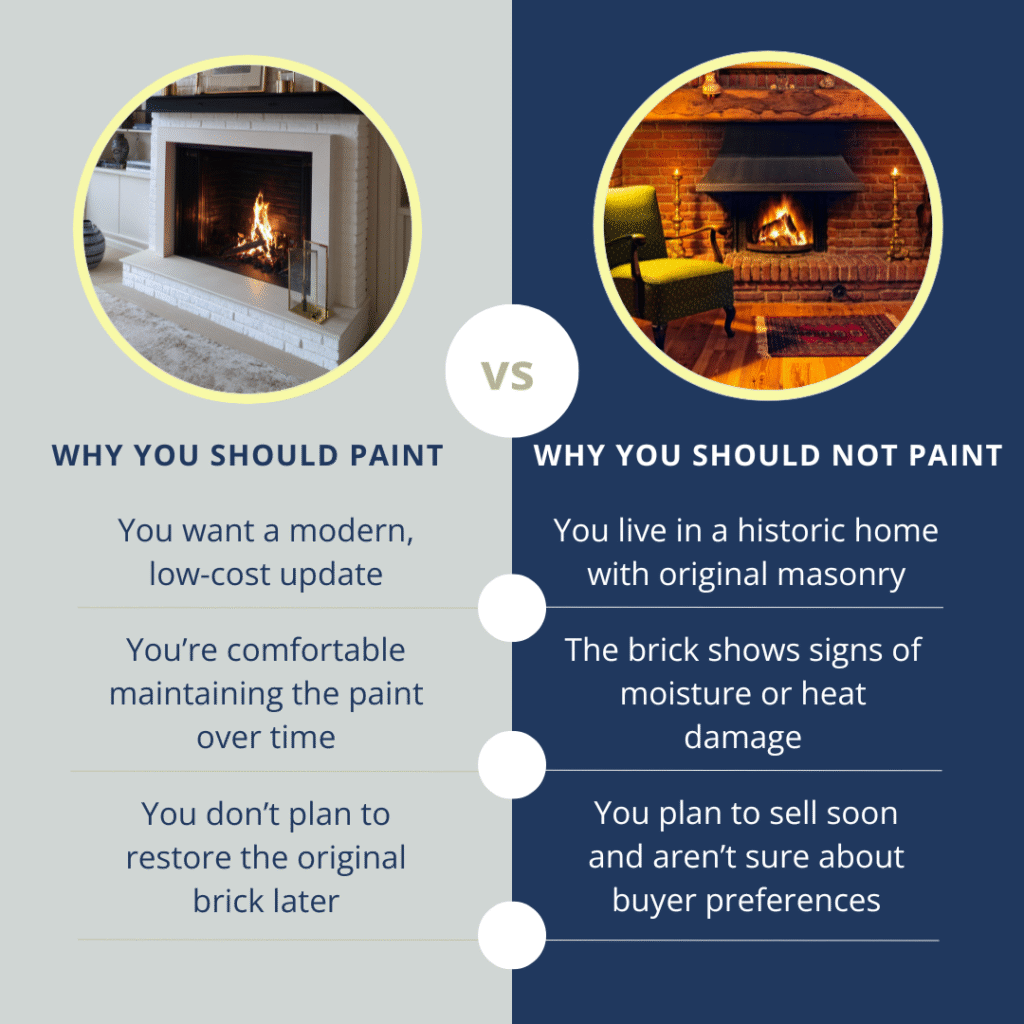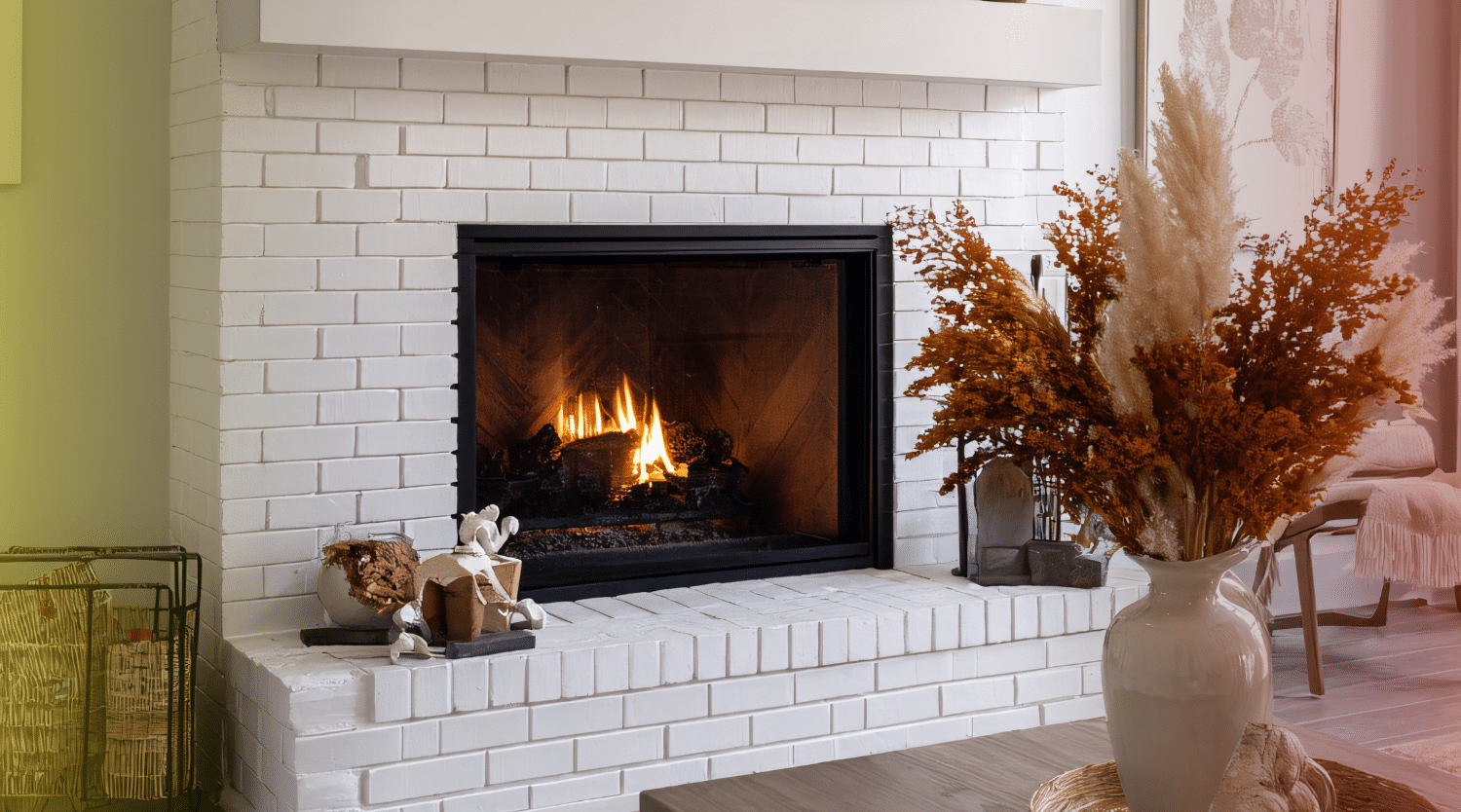A painted brick fireplace is exactly what it sounds like: a traditional brick fireplace that’s been coated with primer and paint to change its color or finish.
Many homeowners choose this project to refresh outdated or dark brick that doesn’t match the rest of the décor. Painting can completely transform the look of your living space.
A dull red or brown brick can become bright white, charcoal gray, or even soft beige, instantly modernizing your home. It’s an affordable upgrade, but should you opt in for your home?
Why Do People Choose Painted Brick Fireplaces?
- To match modern or minimalist interiors
- To lighten a dark room
- To cover discolored or uneven brick tones
- To create a smoother, cleaner finish
This growing trend also connects to resale value. Buyers are often drawn to updated interiors that feel fresh and move-in ready.
In fact, 56% of prospective homebuyers said buying a home that was move-in ready and required no repairs was very important.
Pros of a Painted Brick Fireplace
A painted brick fireplace can offer several benefits for homeowners, especially those looking for quick ways to enhance their space without breaking the bank.
1. It Instantly Modernizes the Room
Painting brick gives your home an immediate facelift. A bright white or soft gray finish can make an older fireplace look brand new and tie your décor together.
2. It’s Affordable and DIY-Friendly
Unlike a full remodel, painting brick doesn’t require demolition or expensive materials. With basic supplies like primer, paint, and a brush, you can achieve professional results for anywhere between $350 -$650.
3. Easier to Clean and Maintain
When properly sealed, painted brick resists soot, smoke, and stains better than raw brick. Dust and ash can be wiped away easily with a damp cloth.
4. It’s a Fast Project with Big Impact
Painting can often be done in a weekend, making it one of the quickest and most cost-effective home improvements for visual impact.
5. Helps Seal Brick Pores
Paint acts as a barrier, sealing porous brick and preventing dirt from settling deep inside. This can make the surface more uniform and help it last longer when maintained correctly.
Pro Tip: For homeowners planning to sell soon, a clean, modern fireplace can make a strong first impression during showings and inspections.
Cons of a Painted Brick Fireplace
Before you pick up the paintbrush, it’s important to understand the downsides. Once you paint your brick fireplace, it’s nearly impossible to reverse the process.
1. The Change Is Permanent
Brick is porous, so paint soaks deep into its surface. Removing it later would require heavy sanding or chemical stripping, which can damage the brick.
2. Risk of Moisture Trapping
If the brick wasn’t sealed correctly before painting, moisture could get trapped beneath the surface. This may cause peeling, bubbling, or even structural issues inside the masonry over time.
3. High-Heat and Maintenance Challenges
Fireplaces are exposed to heat and smoke. Over time, even heat-resistant paint can peel or discolor near the firebox, leading to frequent touch-ups.
4. May Affect Home Inspection Findings
Inspectors often note when a fireplace has been painted because paint can hide cracks, soot stains, or signs of past damage. This doesn’t mean it’s unsafe, but it can make an inspection more detailed.
5. Some Buyers Prefer Natural Brick
While painted brick is trendy, some buyers see it as a downgrade, especially in older or historic homes where original materials add character and value.
Pro Tip: Before painting, have your fireplace checked for cracks, creosote buildup, and moisture problems. Addressing these first prevents future repair costs.
How to Paint a Brick Fireplace Safely and Correctly
If you decide to move forward, the key is proper prep work. Skipping steps could lead to flaking paint or poor results.

Safety tip: Always use paint labeled for fireplaces or high-heat areas. Regular interior paint may peel or emit odors when exposed to heat.
If you’re not sure whether your fireplace is safe for painting, schedule a fireplace and chimney inspection first. A certified home inspector can identify underlying issues like poor ventilation or moisture buildup that should be addressed before painting.
When to Call a Home Inspector Before Painting Your Fireplace
Many homeowners skip this step, but it’s one of the smartest things you can do. A professional inspection ensures your fireplace is structurally sound and safe to use.
Here’s what an inspector looks for:
- Cracks in brick or mortar joints
- Moisture or mold inside the chimney
- Signs of smoke backdraft or poor ventilation
- Evidence of previous heat or water damage
- Loose or deteriorating firebox materials
Why it matters: Painting over hidden issues can trap problems beneath the surface. Once painted, those issues become harder to identify and more expensive to repair.
Example: A homeowner paints over a hairline crack in the brick. Months later, moisture enters the crack and causes chipping paint and interior wall damage. An inspection before painting could have prevented it.
If your fireplace hasn’t been inspected recently, schedule one with P.I. Home Inspection Services to make sure everything is safe before you start your project.
Is a Painted Brick Fireplace Right for You?
Ultimately, the answer depends on your goals.
Choose a painted brick fireplace if:
- You want a modern, low-cost update.
- You’re comfortable maintaining the paint over time.
- You don’t plan to restore the original brick later.
Avoid painting if:
- You live in a historic home with original masonry.
- The brick shows signs of moisture or heat damage.
- You plan to sell soon and aren’t sure about buyer preferences.
Visual Tip: You can always try whitewashing or limewashing instead. These methods lighten brick without fully covering the natural texture, offering a softer look that’s easier to reverse.

Related Questions
Homeowners considering fireplace updates often ask these related questions:
Can painting my brick fireplace affect my home inspection?
Yes. Inspectors may spend extra time checking for hidden cracks, moisture, ventilation problems, or other damage that could be masked by paint.
What kind of paint should I use for a fireplace?
Use heat-resistant masonry or latex paint rated for high temperatures. Regular interior paint won’t last on a fireplace.
Does painting the brick lower the home value?
Not necessarily. In most cases, a neat, well-painted fireplace and chimney enhance value. The key is quality workmanship and color choice.
Should I hire a professional painter or do it myself?
If your fireplace is large or heavily used, consider a pro. They can ensure proper sealing, heat-safe materials, and a lasting finish.
When to Call a Professional
If you notice cracks, peeling paint, or a lingering smoke smell, don’t try to fix it yourself. These can signal deeper issues inside your chimney or firebox.
Call a professional home inspector when:
- Your fireplace hasn’t been inspected in over a year.
- You’ve noticed smoke leaks or draft problems.
- You plan to sell or remodel your home.
Conclusion
A painted brick fireplace can be a stunning centerpiece when done correctly, but it’s not for everyone. The key is preparation. Knowing your fireplace’s condition and choosing materials that will last.
Before painting, invest in a professional inspection to ensure your fireplace is safe, structurally sound, and free of hidden issues. Whether you decide to paint or preserve the natural brick, the goal is the same: a cozy, beautiful space that’s safe for you and your family.
Contact P.I. Home Inspection Services today to schedule your fireplace inspection and get expert guidance on maintaining a safe and stylish home.

